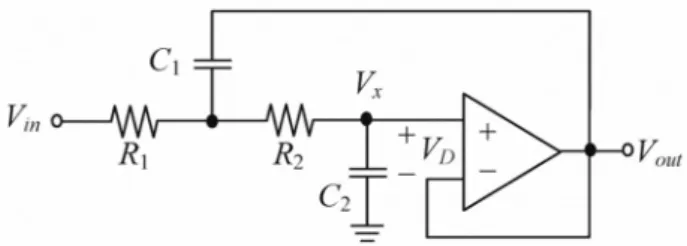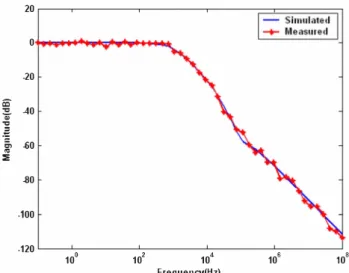Improvement of Stop-Band Attenuation for the
Sallen-Key Low-Pass Filter
Hsin-Wen Ting and Hung-Yu Wang Department of Electrical Engineering National Kaohsiung University of Applied Sciences
Kaohsiung, 807, Taiwan E-mail: hwting@cc.kuas.edu.tw
Abstract-A Sallen-Key low-pass filter configuration with improved stop-band attenuation is presented. The proposed configuration simply connects an additional capacitor which is in parallel to the filter's output to effectively reduce the high-frequency impedance and consequently the undesired high-frequency feedthrough. The relationship between the additional capacitor and high-frequency feedthrough is also investigated to verify its feasibility. The proposed Sallen-Key low-pass filter configuration combines the advantages of simplicity and improved stop-band attenuation which make it attractive for practical application. The simulation and measurement results also confirm the theoretical prediction. Index Terms-low-pass filter; Sallen-Key filter; operational amplifier; attenuation
I. INTRODUCTION
A
very important application of the low-pass filter is in antialiasing or smoothing for sampled data system and interference reducing for electrocardiogram (ECG) system and so on [1-5]. The use of the low-pass filters is to transmit the pass-band signal but attenuate the unwanted high-frequency signal which is above the cut-off frequency. The Sallen-Key (SK) filter is used to implement second-order active filter that is particularly valued for its simplicity [6-9]. Ideally, the transfer function of the SK low-pass filter will continually decrease with increasing frequency. Consequently, the attenuation of any input signal in the frequency range above the cutoff frequency might be expected. However, the actual response turns around and starts to increase at a frequency above the cutoff frequency because of the nonideal characteristics of the operational amplifier (op amp) and increased high-frequency feedthrough between the input and output [10-13]. The above mentioned op-amp nonideality and high-frequency feedthrough would make the stop-band attenuation no longer continue to drop indefinitely with increasing frequency and degrade the S-K filter's high-frequency performance. The use of transconductance-C (OTA-C) or multiple feedback filters could be selected to enhance the high-frequency performance. However, the nonlinearity and temperature dependency of OT A and reverse of sign between input and output make practical difficulties in the application [8-9].In the proposed configuration, the stop-band attenuation could be improved by simply connecting a parallel capacitor in the output of the SK low-pass filter. At the high-frequency stop band, the equivalent low impedance
This work was supported by the National Science Council of Taiwan under Grants NSC-98-2218-E-lSl-006 and NSC-99-2221-E-lSl-064
978-1-4244-6694-8/10/$26.00 ©2010 IEEE
of parallel capacitor drastically reduces the output impedance of the SK low pass filter and consequently the high-frequency feedthrough. But the equivalent high impedance of parallel capacitor makes almost negligible effect to the filter's output within the low-frequency pass band. Therefore, the stop-band attenuation can be improved while the low-frequency signal is still transmitted by the nature of the SK low-pass filter. Then, simulations and measurements for the proposed configuration are also made to verify the potentialities.
II. IMPROVED SALLEN-KEy LOW-PASS FILTER
The stop-band limitation in the typical SK low-pass filter will be described in the beginning of this section. Next, the proposed SK low-pass filter configuration with improved stop-band attenuation is introduced and illustrated.
A.
The Stop-Band Limitation of the Typical SK Low-Pass
Filter
The SK filter employs one op amp to provide a second-order transfer function. A typical unity gain SK low-pass filter is shown in Fig. 1[6, 8]. The op amp serves as a unity-gain buffer. In addition, the output impedance will be restricted to be a very small value because of the feedback [8-9].
Fig. 1 Typical unity gain SK low-pass filter
Ideally, the cutoff frequency % and quality factor
Q
areexpressed in terms of the components: I
%=
--CP2R/S
Q=.JC: �
.JC;
R] +R2
(1) (2) The SK low-pass filter is expected to transmit low-frequency signals but attenuates signals with frequencies higher than the cutoff frequency %. The low-frequencyfeedthrough between the input and output is almost 158
Fig. 5 Simulation (in solid line) and measurement (in asterisked line) results of a typical SK low-pass filter with a cut-off frequency of 1 kHz
A parallel capacitor Cex1 can be added to the output of filter to improve the stop-band attenuation from the conclusion described in Section II. Theoretically, a 50-% reduction of feedthrough is predicted and the frequency ltbn is still
approximated to be about 111 KHz by (9). The high-frequency feedthrough is predicted to be about -60
dB
by (10) and observed in solid line of Fig. 6. Similarly, 50 measurements are also plotted as an asterisked line in Fig. 6 to show the measured frequency response. The high-frequency feedthrough is measured to be about -58
dB
by observing Fig. 6. 20 0 -20 s:; "" -40 or "" .� :;, to �o ::;; .80 -100 -120 10° 102 104 106 108 Frequency(Hz)
Fig. 6 Simulation (in solid line) and measurement (in asterisked line) results of the improved SK low-pass filter with a cut-off frequency of 1 kHz
The measured results show good agreement with the simulated ones as illustrated in Fig. 6 and Fig.6, respectively. In addition, A 6-dB improvement of stop-band attenuation (from -52 dB to -58
dB)
is observed at the frequency of ltbnby comparing the measured frequency response illustrated in Fig. 5 and Fig. 6.
IV. CONCLUSION
In this paper, a Sallen-Key low-pass filter configuration with improved stop-band attenuation is presented. In the proposed configuration, an additional capacitor which is in parallel to the filter's output effectively reduces the high-frequency impedance and consequently the high-frequency feedthrough. The advantages of simplicity and improved stop-band attenuation make it attractive for practical application. The frequency that actual response turns around and starts to increase is analyzed and theoretically predicted. In addition, the relationship between the added capacitor and reduction of feedthrough is also evaluated with appropriate approximations. Simulations and measurements are both made to verify the potentialities of the
proposed configuration. Good agreements can be observed between the simulated results and measured ones.
REFERENCES
[1] P.E. Allen and D.R. Holberg, CMOS Analog Circuit Design. Oxford University Press, Oxford, 2002.
[2] C.S. Wang and P.C. Huang, "A CMOS low-IF programmable amplifier with speed-enhanced DC offset cancellation," in Proc. IEEE Int. Asia-Pacific Con! Circuits and Syst., May 2002 pp. 133-136. [3] Ramet S, "A low-distortion anti-aliasing/smoothing filter for sampled
data integrated circuits," IEEE J. Solid-State Circuits, 1267-12780 vol. 23, pp. 1267-1278, Oct. 1988.
[4] F. Meng and W. Liao, Hardware design specifications: Project: ECG Monitoring Module, Rev.4.0, Analog Devices Inc., 2007.
[5] J. G. Webster, Medical Instrumentation Application and Design. New York: Wiley, 1998.
[6] B. Razavi, Fundamentals of Microelectronics. Wiley, New York, 2008. [7] P.E. Sallen and E.L. Key, "A practical method of designing RC-active
filters," IEEE Trans. Circuits Syst., vol. 2, pp. 74-85, Mar. 1955. [8] R. Schaumann and V. Valkenburg, Design of Analog Filters. Oxford
University Press, Oxford, 2001.
[9] L.P. Huelsman, Active and Passive Analog Filters: an Introduction.
Mcgraw-Hill, New York, 1993
[10] H Schmid and G.S. Moschytz, "Fundamental frequency limitations in current-mode Sallen-Key filter," in Proc. IEEE Int Symp Circuits and Systs, May 1998 pp 57-60.
[11] B.C. Baker, Stop-band limitations of the Sallen-Key low-pass filter, application notes, Texas instrumentation, www.ti.com. 2008
[12] V. Michal and Sedlacek, "Low-pass biquadratic filters with high suppression rate," Electronics Letters, vol. 45, pp. 591-593, Dec. 2009. [13] R. P. Geffe, "Exact synthesis with real amplifiers," IEEE Trans.
Circuits Syst., vol. 21, pp. 369-376, Mar. 1974.

